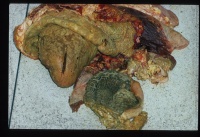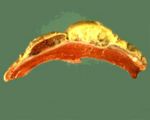Traumatic Reticulitis
Also known as: Hardware Disease — Traumatic Reticuloperitonitis — Wires
Also see: Traumatic Pericarditis
Introduction
Due to their unselective feeding habits, cattle may ingest a variety of foreign bodies. Cattle cannot spit out metallic agents (e.g. screws, nails, pieces of wire, bottle tops) once in their mouths, and so ingest them. Heavier metallic objects consumed can become lodged in the reticulum, and may penetrate the reticular wall under the influence of the continuous reticular movements or forces caused by pregnancy and parturition.
Pathological changes depend on the direction of penetration; this is usually in an anterior-ventral direction. Pyogenic bacteria escape from the reticulum, causing localised peritonitis and local fibrinous adhesions. Penetration of the diaphragm and pericardium results in pericarditis. Penetration of the heart itself results in myocarditis and endocarditis. Penetration of the lungs and pleura can occur resulting in pneumonia and pleurisy. Liver and splenic abscesses also occasionally occur following penetration of either organ.
Signalment
More frequently affects adult dairy cows but does also affect beef animals. More common in cows grazing a pasture where there has been a previous building.
Diagnosis
Can often be made following a good history and physical exam.
Clinical Signs
Signs are often vague, but adult cattle will show a drop in milk production and fecal output is decreased. The rectal temperature is often mildly increased. The heart rate is often increased, and respiration is usually shallow and rapid. Initially, the cow exhibits abdominal pain with an arched back; and a reluctance to move often with abducted elbows.
Affected animals will also grunt in response to the 'bar test' - Two people, one on each side of the cow, hold a bar/pole underneath the animal in the region behind its front legs. They attempt to 'lift' the cow and the cow grunts in response to the pressure on its chest.
Laboratory Tests
Although not always necessary, can sometimes be useful to rule out other differential diagnoses. On haematology a neutrophilia will be present with a left shift. Fibrinogen and total protein levels will also be high. A hypokalaemia and hypochloraemia with a metabolic alkalosis will also be present.
A peritoneal tap is a useful diagnostic aid to establish if peritonitis is present, if so a high protein and a high cell count will be evident. These parameters however will return to normal once the infection has already been walled off into an abscess.
Pathology
Thick walled, pus filled abscesses form around the points of penetration, which may be multiple. The foreign object may be found in one of these abscesses, or free in the reticular lumen.
If the pericardium is penetrated it becomes thickened with oedema, and purulent fluid containing fibrin clots accumulates in the sac giving a “bread and butter heart” which is classical of traumatic reticulitis.
Additionally if the liver is affected large abscesses in the dorsal part of the liver may erode into the posterior vena cava to produce a thrombosis.
Treatment
Typically these cases are recognised late in the course of disease and euthanasia is often the most economical option.
If the condition is diagnosed early in the course of disease then treatment can be medical or surgical. Medically antibiotics can be administered in order to treat the peritonitis and a broad spectrum antibiotic such as oxytetracycline is a good choice. A magnet should also be administered to prevent further metal penetration of the reticulum. Restricting the movement of the animal may also prevent further penetration of the foreign object.
Surgery involves a rumenotomy allowing removal of the object. If an abscess is adhered to the reticulum, it should be drained into the reticulum. Antibiotics should also be given perioperatively.
Prevention
Animals should not graze fields where they may have access to metal objects or where construction has recently taken place. Pastures should be cleared as much as possible of metal wire and such like prior to animals grazing. Additionally magnets can be administered to the cattle orally, these then remain in the reticulum and if metal objects are ingested they will remain attached to the magnet.
Literature Search
Use these links to find recent scientific publications via CAB Abstracts (log in required unless accessing from a subscribing organisation).
Traumatic Reticulitis in cattle publications
References
Merck & Co (2008) The Merck Veterinary Manual (Eighth Edition) Merial
| This article has been peer reviewed but is awaiting expert review. If you would like to help with this, please see more information about expert reviewing. |


